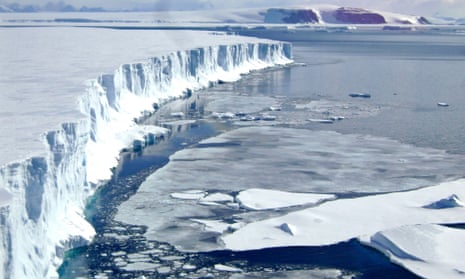The largest ice shelf on the Antarctic peninsula is thinning because of warmer ocean and air temperatures that are driving it towards a collapse that could contribute significantly to sea level rise, a new study has found.
The study by the British Antarctic Survey (BAS) analysed the Larsen C ice shelf, which is two and a half times the size of Wales. The team looked at satellite radar imagery taken between 1998 and 2012 to find that Larsen C lost 4 metres of thickness.
Until now scientists did not know whether the losses were coming from above or below. The new work found both play a role, but the main driver is ice loss from below.
Lead author Dr Paul Holland said: “What’s exciting about this study is we now know that two different processes are causing Larsen C to thin and become less stable.”
The major loss occurred underneath the shelf where it floats on increasingly warm ocean currents. Around 28cm every year across the entire area of the ice shelf is being eaten away from below.
As they thin, ice shelves become prone to collapse. The much smaller Larsen A and B ice shelves collapsed catastrophically in 1995 and 2002 respectively. Although vast, the amount of water contained in the shelves themselves is insignificant in terms of its impact on sea level rise. It is the ice they hold behind them that concerns scientists and poses a risk to coastal communities around the world.
Ice shelves act as a brake on glaciers flowing from the land by plugging the bays they flow into with solid floating ice. Scientists recently warned that the collapse of ice shelves across much of Antarctica could lead to metres of sea level rise in the future.
Professor David Vaughan, director of science at the BAS, said Larsen C could collapse within a matter of decades. The glaciers behind the shelf hold enough water to add a few centimetres to the global sea level.
Vaughan said: “When Larsen A and B were lost, the glaciers behind them accelerated and they are now contributing a significant fraction of the sea-level rise from the whole of Antarctica. Larsen C is bigger and if it were to be lost in the next few decades then it would actually add to the projections of sea-level rise by 2100.”

Holland said the study, which was published in the Cryosphere journal on Wednesday, found the layer of snow on top of the shelf was also becoming more compact, probably because warmer air was melting the snow and filling into air pockets.
The compacted ice pushes the fragile shelf closer to collapse by allowing meltwater to pool on its surface. This can then run into cracks that form in the ice and eventually be the catalyst for the total disintegration of the shelf.
The peninsula is one of the most most rapidly-warming places on Earth. The warmer air contributed another 3.7cm per year to the thinning of the ice shelf, from above.
Vaughan said the finding that oceanic warming is the major driver could mean that ice shelf collapse may not be restricted to the Antarctic Peninsula.
“The Antarctic Peninsula is exceptional in being the warmest part of Antarctica and if we understand ice shelf collapse being a response to atmospheric warming then it will continue to limited to the Antarctic Peninsula for many decades.
“But if, as this piece of work is beginning to indicate, the oceans have a role in the Antarctic Peninsula as well then actually we have to start thinking about ice shelves around the rest of the Antarctic on those same time scales of several decades,” he said.

Comments (…)
Sign in or create your Guardian account to join the discussion